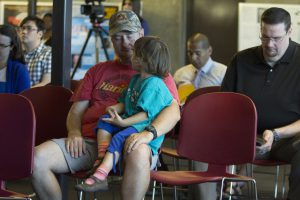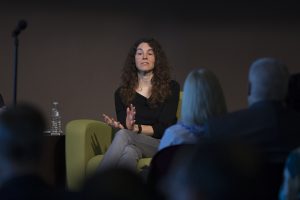- Slug: PBS Kids, 540
- Photo available (thumbnail, caption below)
By ALLY CARR
Cronkite News
PHOENIX – When Claire Stoehr was less than a year old, she began watching “Super Why,” a PBS show that teaches kids reading skills.
”At the time, I think it was the first thing on, and just from the repeated viewings of that, she was able to pick up – easily – two thirds of the alphabet,” said her father, Chris Stoehr. Both of his daughters, now 5-year-old Claire and 3-year-old Jaina love to watch shows on that channel.
“The only reason we have cable is for PBS,” he said. “For the kids programming.”
Arizona PBS will launch a new cable channel – digital channel 8.4 – in January that will broadcast free educational shows for kids, with a focus on improving educational outcomes in underserved communities.
“It will be 24 hours a day, seven days a week so that all kids will have unrestricted access to our educational content,” said Linda Simensky, vice president of children’s programming for PBS.
Simensky leads the PBS KIDS programming team, which uses research to create the educational content of the shows.
“At PBS KIDS, our goal is not to encourage kids to watch more TV. Our thinking is, when they are going to watch TV, we want to make sure that they have programming that is beneficial, age appropriate and fun to watch,” she said.
More than one quarter of PBS viewers live in homes with annual incomes less than $20,000, Simensky said.
Forty percent of PBS KIDS viewers come from broadcast-only homes, which means the kids in these homes aren’t accessing PBS content over the internet or on any devices. Perhaps most of these broadcast-only homes are low income and at risk, with broadcast as their only access educational content, said Keith Kennebeck, director of children’s programming at PBS.
“In broadcast-only homes … it’s key to reach kids when they’re watching TV the most. That’s now in the evenings and on weekends,” he said. “Unfortunately, these are times that many PBS member stations don’t offer kids programming. So by creating a nationally distributed 24/7 service, we are enabling all of our member stations to reach kids with our best content at times when we know that they’re watching TV the most.”
The content for the new 24/7 service is distributed nationally to local member stations. PBS will allow member stations to insert an hour of local programming every weekday between 6 a.m. and 5 p.m., Kennebeck said.
Arizona PBS is part of ASU’s Walter Cronkite School of Journalism and Mass Communication. Cronkite News is the student-operated news division of Arizona PBS, which reaches about 1.9 million households.
“If we don’t begin to do something, and something very important and very critical to build children’s vocabularies and begin their literacy skills, their numeracy skills, and all these kinds of things at a very young age when those brains are developing, then we’re missing the mark,” said Carole Basile, dean of the Mary Lou Fulton Teachers College at Arizona State University.
Other parents agree that PBS Kids programming is great because it is educational.
“(Kids) get absorbed in television. And if they’re going to get absorbed in something, it should be something that’s going to grow their minds,” said Stacey Mannari, a teacher and mother of two.
^__=

